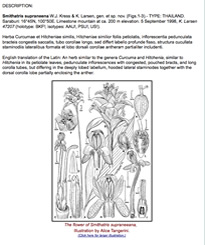NYBG Science in the News: Plain English and the Tree of Life
Posted in NYBG in the News, Science on January 30 2012, by Ann Rafalko
The turn of the year from 2011 to 2012 was an exciting time for the scientists who work, teach, and research at The New York Botanical Garden.

In December, scientists at the Botanical Garden, the American Museum of Natural History (AMNH), New York University, and Cold Spring Harbor Laboratory announced that they had created the largest genome-based tree of life for seed plants to date. In January, James S. Miller, Ph.D., Dean and Vice President for Science at the Garden, explained important changes in the requirements for the naming of newly discovered plants beginning in 2012. Earlier in 2011, Dr. Miller had been the lead author on an article in the online journal PhytoKeys summarizing the changes. To say that these scientific advancements are huge is a gross understatement, but how to understand them?
Let’s use plain English, which is exactly what the new plant-naming requirements do. As outlined in an op-ed published in the New York Times on January 22, Dr. Miller, who took part in the International Botanical Congress in Melbourne, Australia, where the changes were approved, explains that plants will still be named in Latin, but that they will no longer have to be described in Latin. This laborious process–which has been on the botanical books since 1908–is only the first hurdle each botanist must clear before he may name a new plant species. The next step, the publishing of this description in a printed, paper-based journal, has also been done away with by the International Code of Botanical Nomenclature in an effort to speed the naming of plants. Why the hurry? As Dr. Miller says, “as many as one-third of all plant species (may be) at risk of extinction in the next 50 years.” One way to save a plant is to name a plant. From there, scientists–freed from the strictures of Latin–may further investigate the plant and all of its potentialities.
And how did all these plants come into being? Charles Darwin described the explosion of flowering plants in the fossil record as the “abominable mystery.” And while the exact reasons for each flowering plant’s evolution may remain a mystery, their relationship to each other is no longer so.

Using a new approach known as “functional phylogenomics,” scientists have been able to recreate the pattern of events that has given the world a wide diversity of seed plants (pdf of the press release). Why do seed plants matter? The group of 150 plants studied by the group contains everything from peanuts and tomatoes, to pine trees, orchids, tobacco, lettuces, and roses. This group of plants has huge economic significance; understanding how and when evolutionary adaptations such as drought tolerance and disease resistance occur in these plants is vital to the future of humanity. This new tree of life may “enable us to identify genes involved in ecological responses,” according to Dennis Stevenson, Vice President for Laboratory Research at the Garden, allowing scientists to predict how changes in climate and weather patterns may induce some species to become invasive or out of control.
To complete the tree of life, sequences of the plants’ genomes were taken from pre-existing databases or generated from live specimens at the Garden or in the field. The sequences were then grouped, ordered, and organized into a tree based on their evolutionary relationships using algorithms developed at AMNH and NYU, and the processing power of supercomputers at Cold Spring Harbor Laboratory and overseas. The data and software resources generated by the researchers are publicly available and will allow other comparative genomic researchers to explore plant diversity and to identify genes associated with a trait of interest or agronomic value. These studies could have implications for improving the quality of seeds and, in turn, agricultural products ranging from food to clothing. In addition, the phylogenomic approach used in this study could be applied to other groups of organisms to further explore how species originated, expanded, and diversified.
As the Garden’s tagline says, we have been studying, exhibiting, and conserving plants for 120 years, and now our scientists have helped give the world two new tools for continuing to do so. Here’s to another 120 years!

